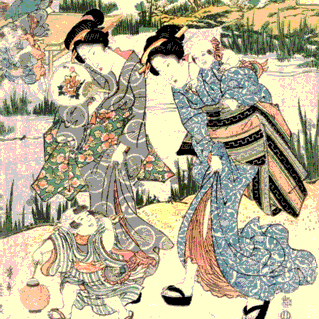Mottainai
 In recent years, problems of resources and energy have become international issues, and transformation to a sustainable recycling society is urgently needed. So what should form the basis of a recycling society? We can find a clue in <Edo>, Tokyo in the 17th-19th century (the Edo era). Edo functioned as a recycling society based on the spirit of “mottainai (what a waste).”
In recent years, problems of resources and energy have become international issues, and transformation to a sustainable recycling society is urgently needed. So what should form the basis of a recycling society? We can find a clue in <Edo>, Tokyo in the 17th-19th century (the Edo era). Edo functioned as a recycling society based on the spirit of “mottainai (what a waste).”
Edo in that period was home to a population of one million people, but the lives of townspeople had to be earned with limited resources. Therefore, any wasteful use of resources was very “mottainai”. Kimono are a good example. In the Edo Era, as all fabrics were hand-made, the productivity was low. And kimono were therefore very valuable. Kimono were not only recycled as secondhand kimono, but also reformed as futon, zabuton (Japanese flat-type cushions), drawstring bags and so on. Cotton kimono were reformed as diapers or dusters and used up. The structure of kimono facilitates recycling as the fabric is cut straight at a standard width. In the end, kimono were burnt to ashes. Then, how were the ashes treated? In Edo, since almost all everyday items including kimono (except hardware or pottery) were made from plants, they were reduced to ashes of plant origin. The ashes were saleable; they were stored in boxes and sold to venders. The ashes were not only used in the processes of saké brewing, paper manufacturing, and dyeing, but also were used as glazes for pottery, as agricultural fertilizer, as detergents and so on. There were many other recycling businesses in Edo, but the major part consisted of kimono, ashes and manure of body waste origin. Dumping of manure was also “mottainai” in Edo. Farmers bought manure from the Edo townspeople as it could be used as organic fertilizer, rich in nitrogen and phosphorus. The recycling system of Edo functioned in this way, based on the “mottainai” concept.
The meanings of the word mottainai can be denoted in English with 3 Rs to do with resources: “reduce (reduce waste generation),” “reuse” and “recycle”. In addition, mottainai carries the meaning of appreciation for nature: “respect.” For us living in this age, the spirit of “mottainai” can be a key word toward the transformation to a recycling society.
Wangari Muta Maathai who received the Nobel Peace Prize in 2004 was impressed by “mottainai” and disseminated it to the world. She knew this word from her visit to Japan in 2005 and insisted that global environmental problems and the uneven distribution of resources would be improved, and wars and terrorism would tend to be suppressed if “mottainai” could become a universal word and its spirit could be understood. She engaged in the dissemination of this word through the “MOTTAINAI campaign.”
After her death in September 2011, the spirit of “mottainai” is still gathering pace around the world. Her funeral, held in October 2011, was based on the “mottainai” spirit. The Kenyan president, persons from international institutions and about ten thousand people attended her funeral in the park where the “Mottainai” banner was raised. According to her testament not to cut down trees, her body was placed in a coffin mainly made from bamboo branches.
(Rieko Tanimoto)










